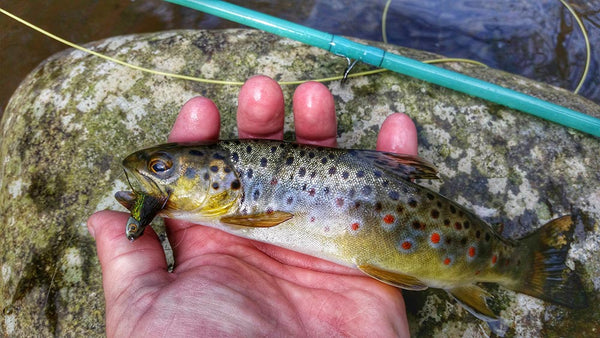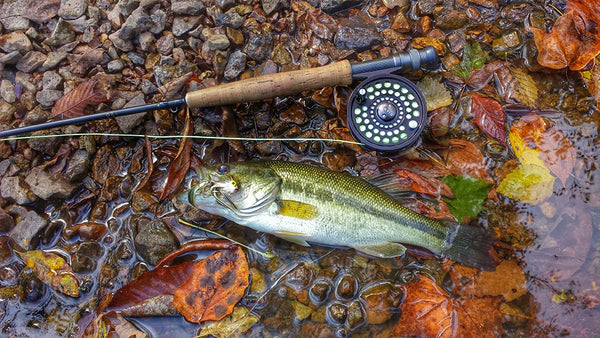Small Water Fly Fishing: Streamer Design and Tactics


I often struggle with deciding on which type of water I want to fish, whether it's big water with big flies and sinking lines, or small streams with downsized offerings. Both can be very rewarding but there’s something special about small streams and exploring where smaller predatory fish can live.
My definition of a small stream, warmwater or coldwater, is a watershed that is at the max 25 feet wide and a deep pool from 4 to 5 feet deep. Where I live this even includes a few tailwaters, which when generating are not navigable by boat.
These types of waters contain more than just bugs for fish to feed on. After many years of exploring these little gems and talking with other small stream fanatics, I've come up with my own way to target the meat eaters in these waters with downsized streamers.
Streamer Design

Profile
The first thing I think of when filling my small streamer box is how big the baitfish are in the waters I’ll be fishing. My nominal streamer size for this type of fishing is 2 to 3.5 inches.
If you are specifically targeting bass, make sure to tie flies on the upper end (size wise) to deter as many sunfish as possible.
Keep in mind any and all materials you are adding to the hook and try to minimize unnecessary weight because this type of fishing is most enjoyable with lighter rods (3-5wt).
Action

How do you want it to swim? I remember asking Mike Schimdt of Angler's Choice Flies about carrying small streamers on his annual small water hopper trip. He said he carried small streamers that had specific actions when stripped.
Fly Tying: Why Is My Baitfish Pattern Swimming Wrong?
I always include some neutrally buoyant baitfish, some jiggy-style streamers, and a few just for dead drifting. All of these can trigger a strike and in small water you'll quickly know if they'll commit to strike.
Depth
Small streams generally aren't deep, but you still need to be able to fish the entire column of the pool.
Take the average flow on the water you fish and any submerged structure into account. There’s nothing worse than carrying a box of unweighted streamers and then walking upon a deep plunge pool with a ledge 3 ft below.
Always carry Clouser-style or Sculpin Helmet streamers that have the hook pointed upward and will allow you to effectively fish the bottom of pools without snagging.
Of course, having those unweighted streamers is also necessary – when stripped they imitate dying prey and don’t nosedive straight to the bottom before a suspended fish can key in on them.
Equipment
Fly Rod
Depending on stream size, I most often carry a 8.5ft glass 5wt but I drop down to as low as a 6.6ft 3wt on tiny bluelines. Rod action is dependent on your personal preference but I’m a glass geek and prefer a medium to medium fast action rod. To me, glass or slower graphite shines in small water….you can manipulate your streamer easily, feel everything, and great tippet protection.
Fly Line
As for lines, there’s no need to use a sink tip line here like you normally use on big flows. Your basic WF line will suit anything you should encounter. Although ( if available) I try to buy the drab color line for added stealth.
Leader & Tippet
I drop down a few sizes from what I normally use on the river. I use a leader that is the length of my rod, fluorocarbon, and I stay in the 3x-4x range. This will allow turnover of the fly but still adds stealth to the approach…although most fish striking a streamer aren’t too worried about the leader.
Gear
For carrying everything, I take the minimalist approach…..a lanyard with nippers and tippet, along with a Tacky fly box full of confidence patterns (such as Strolis Micro Picks, Groupie Sculpins, Skulpin Bunnies, and Panther Branch Crafty Creek Minnows to name a few).
Clothing
Wear muted clothing or clothing that matches the surroundings. This isn’t the place for your neon yellow fishing shirt.
Approach

Approach From Downstream
Make short casts beginning at the pool tailout. This way you're not casting over fish and spooking the entire pool.
5 Signs You Might Be A Streamer Junkie
This is even true with small stream bass. I've observed both smallmouth and spotted bass behave very much like trout in these environments – where they feed, how they feed, and even spawning behavior.
Less Casting Is Better.
Pick your target as you approach the run. Casting repeatedly in such a small area is just that… casting. The opportunity to a hook a fish goes down with every cast in the same spot.
Make the first cast your best!
Slow Down Your Retrieve
I have to make this adjustment quite often. It can seem strange going from throwing a 300gr sinking line and 6” weighted streamers on big, fast-moving water to throwing smaller streamers on a floating line in a creek you can hop over!
If you slow down the retrieve and your streamer is designed well, you'll be able to strip and pause while still getting a lot of movement from to the materials themselves moving.
If all else fails to reap a fish, try high-sticking your streamer.
Learn New Casts
You'll be faced with lots of casting obstacles in small stream environments.
The bow and arrow cast can be your best friend! Just make sure you are holding the streamer by the rear hook if articulated – I know from experience!
Any cast that eliminates false casting is your best friend on these waters because it reduces your chances of spooking the fish.
Quick Review
When you don’t have time to rig the boat or you’re a little sore from swinging the big gun all day during full generation, grab your trout rod and some micro-meat, and go explore those places you drive by every day!
Want More Articles Like This?
Subscribe to the Flymen Newsletter at the Bottom of the Page!
About Brandon Bailes:
 Brandon is an engineer tech contractor for NASA by day and at night (after the wife and kids are sound asleep) you can find him at the vise pumping out orders for his "lil" shop Panther Branch Bugs. He specializes in warmwater patterns, from deer hair bugs to streamers. He's a self-professed streamer junkie and loves that he learns something new each time he spends the day throwing meat.
Brandon is an engineer tech contractor for NASA by day and at night (after the wife and kids are sound asleep) you can find him at the vise pumping out orders for his "lil" shop Panther Branch Bugs. He specializes in warmwater patterns, from deer hair bugs to streamers. He's a self-professed streamer junkie and loves that he learns something new each time he spends the day throwing meat.



Register me
SUBSCRIBE ME PLEASE!
Subscribe please!
Subscribe me to your newsletter.
Thanks much,
Chuck
Was wondering if you could explain a little more in depth your approach from downstream of your target. I always fish from upstream and pick apart structure and holding water as I move down, making sure to work from near to far covering everything that looks good. I have turned around and cast upstream when it looks good but can never get good action from my streamer as the current is bringing it back to me. Any hints or tips as to how and why you take this approach? Thank You.
Leave a comment